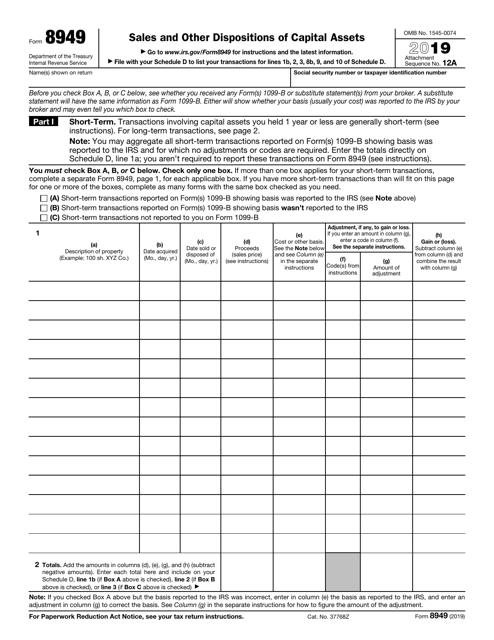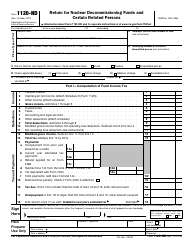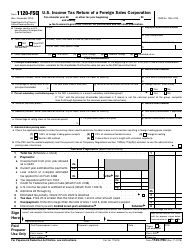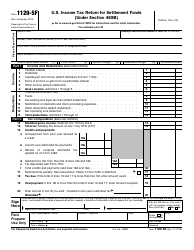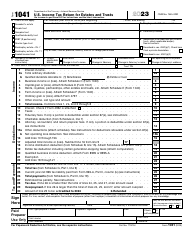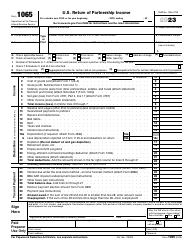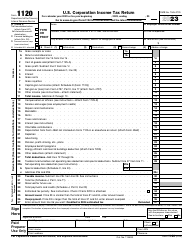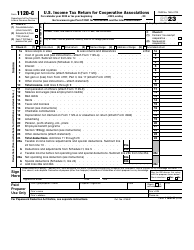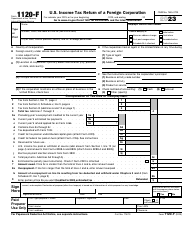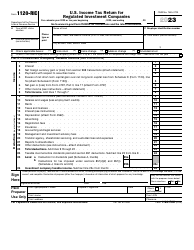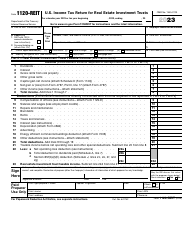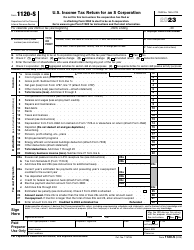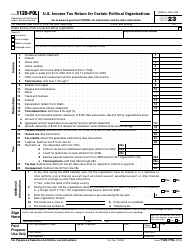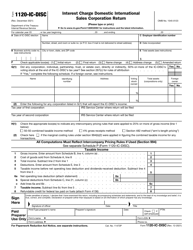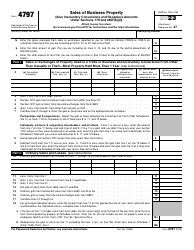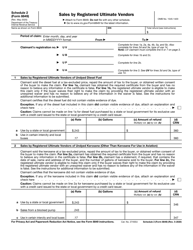This version of the form is not currently in use and is provided for reference only. Download this version of
IRS Form 8949
for the current year.
IRS Form 8949 Sales and Other Dispositions of Capital Assets
What Is IRS Form 8949?
IRS Form 8949, Sales and Other Dispositions of Capital Assets , is a legal document used to report exchanges and sales of capital assets, both long- and short-term capital gains and losses.
When you sell or exchange capital assets, for instance, land, stocks, and artwork, you have to inform the Internal Revenue Service (IRS) of the transaction via your income tax return. To do so, individuals, partnerships, trusts, corporations, and estates fill out IRS Form 8949. This document allows the taxpayer to reconcile amounts reported on Form 1099-B, Proceeds from Broker and Barter Exchange Transactions, and Form 1099-S, Proceeds from Real Estate Transactions, with the amounts you report on your return.
This form was released in 2019 with all previous editions obsolete. You can download an IRS Form 8949 fillable version through the link below.
What Is Form 8949 Used For?
Every capital gain or loss, generated when a capital asset is sold, must be reported to the IRS. Schedule D is submitted to report most capital gain or loss transactions. But before you enter the net gain or loss or Schedule D, you must fill out Form 8949.
To complete IRS Form 8949, you need to separate your capital gains and losses. They may be short-term (one year or less) or long-term (more than one year), depending on how long you held or owned the property. To find out more, you may consult with the IRS instructions for Form 8949.
Follow these steps to report short-term gains and losses (Part I) and long-term gains and losses (Part II):
- Check the boxes that describe the basis of your short- and long-term transactions - the amount of your investment in the property for tax purposes. These transactions were either reported on Form 1099-B and to the IRS (boxes A, D), were not reported to the IRS (boxes B, E), or were not reported to you on Form 1099-B (boxes C, F);
- Write down your full name and social security number or taxpayer identification number;
- Describe the property, enter the date you acquired, sold, or disposed of it, indicate the proceeds you received, and cost or another basis (usually, you need to write down the actual cost of the property);
- Record the appropriate code (see official instructions, pages 7-9) and necessary adjustments to gain or loss;
- Calculate gain or loss on each row by subtracting cost from proceeds and combining the result with the amount of adjustment;
- Indicate the total amounts by adding the proceeds, costs, amount of adjustment, and gain or loss.
IRS 8949 Form must be filed with Schedule D for the return you need to submit. You must enter the totals for all short-term transactions (boxes 1b, 2, 3) and long-term transactions (boxes 8b, 9, 10) reported on Form 8949.
IRS 8949 Related Forms:
- Form 1040, Individual Income Tax Return;
- Form 1040-SR, U.S. Tax Return for Seniors;
- Form 1041, U.S. Income Tax Return for Estates and Trusts;
- Form 1065, U.S. Return of Partnership Income;
- Form 8865, Return of U.S. Persons With Respect to Certain Foreign Partnerships;
- Form 1120, U.S. Corporation Income Tax Return;
- Form 1120-S, U.S. Income Tax Return for an S Corporation;
- Form 1120-C, U.S. Income Tax Return for Cooperative Associations;
- Form 1120-F, U.S. Income Tax Return of a Foreign Corporation;
- Form 1120-FSC, U.S. Income Tax Return of a Foreign Sales Corporation;
- Form 1120-H, U.S. Income Tax Return for Homeowners Associations;
- Form 1120-IC-DISC, Interest Charge Domestic International Sales Corporation Return;
- Form 1120-L, U.S. Life Insurance Company Income Tax Return;
- Form 1120-ND, Return for Nuclear Decommissioning Funds and Certain Related Persons;
- Form 1120-PC, U.S. Property and Casualty Insurance Company Income Tax Return;
- Form 1120-POL, U.S. Income Tax Return for Certain Political Organizations;
- Form 1120-REIT, U.S. Income Tax Return for Real Estate Investment Trusts;
- Form 1120-RIC, U.S. Income Tax Return for Regulated Investment Companies;
- Form 1120-SF, U.S. Income Tax Return for Settlement Funds (Under Section 468B);
- Form 990-T, Exempt Organization Business Income Tax Return (and proxy tax under section 6033(e)).
